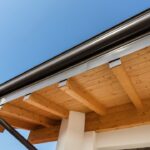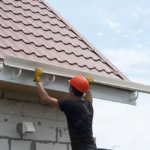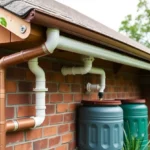For many homeowners, the term roof soffit might not be very familiar. However, it’s an essential part of the roofing structure that contributes significantly to both the aesthetic and functionality of a house. Understanding what is a roof soffit, its purpose, and benefits can help homeowners make informed decisions when it comes to home improvement projects. In this article, we’ll explore the significance of the roof soffit, the different types available, and why it’s here with approved technology making it a big part of modern architectural designs.

The Basics of Roof Soffits
A roof soffit is the material that bridges the gap between a house’s siding and the roof’s overhang. It covers the underside of the roof eaves and plays a crucial role in both aesthetics and house protection. Without it, the roof’s rafters would be exposed, leading to a less finished look and potential exposure to the elements.
The Purpose of Roof Soffits
The primary function of a roof soffit is to provide ventilation to the attic and, consequently, the entire house. Proper ventilation is necessary to prevent issues like mold growth, insulation damage, and excess moisture accumulation. Moreover, roof soffits help maintain a comfortable home temperature, leading to energy efficiency.
Why Ventilation Matters
Ventilation through roof soffits ensures that air circulation in the attic remains optimal. This plays a significant role in temperature regulation throughout the seasons, reducing the load on HVAC systems which can lead to significant utility savings.
Protective Benefits
Roof soffits also act as a shield. They protect the roof structure from weather overflow, pests, and provide a fire barrier. Each of these protective benefits extends the lifespan of both the roof and the homes structure.
Types of Roof Soffits
Aluminum Soffits
Aluminum is a popular choice due to its durability and resistance to elements like moisture and wind. It’s lightweight but sturdy, and it can be painted to match the home’s exterior for a uniform look.
Vinyl Soffits
Vinyl soffits are chosen for their cost-effectiveness and low maintenance. They don’t need painting and are excellent for moist climates as they resist rot and warp.
Wooden Soffits
For homeowners seeking a natural appearance, wooden soffits are ideal. However, they require regular maintenance to prevent decay and pest infestations.
Composite Soffits
Composite soffits bring together materials like recycled wood and plastic, ensuring durability and sustainability. They offer the aesthetics of wood without the extensive upkeep.
Installation and Maintenance of Roof Soffits
Proper installation of roof soffits requires professional expertise to ensure they perform as needed. Incorrect installation can result in poor ventilation or moisture buildup.
Regular Maintenance Tips
Maintenance usually involves cleaning vents to avoid blockage, repainting, and checking for damage. Regular inspections prolong the soffit’s lifespan and efficiency.
Innovations and Technology in Roof Soffits
With technological advancements, roof soffits have been improved for better performance and sustainability. Modern soffits are made with materials that resist extreme weather and come with integrated ventilation systems for optimal airflow.
Smart Soffits
Innovative development has led to soffits equipped with sensors that monitor airflow and temperature, alerting homeowners to any maintenance needs for energy efficiency.
Choosing the Right Soffit for Your Home
Selecting the right soffit requires understanding the home environment, aesthetic preferences, and budget. Consulting with a roofing expert is recommended for tailored advice.
Read more about roofing materials on roofing materials options.
Conclusion
Understanding what is a roof soffit and its importance is crucial for homeowners aiming to maintain or enhance their home’s architecture. From choosing the right material to adopting modern technology, roof soffits are a big part of home improvement today. Their role is not just functional but also a delightful addition to the home’s external appeal.

FAQs About Roof Soffits
What materials are best for roof soffits?
Aluminum, vinyl, and composite materials are highly recommended due to their durability and low maintenance needs.
How often should roof soffits be inspected?
It’s advisable to inspect roof soffits at least once a year, especially after harsh weather conditions.
Can I install soffits myself?
While installation might seem manageable, hiring a professional is recommended to ensure proper fit and functionality.
Visit an external source to learn about costs associated with roofing projects.
This article contains affiliate links. We may earn a commission at no extra cost to you.








